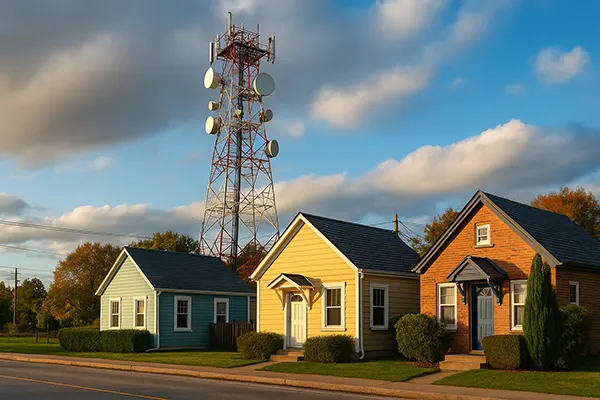Regional Mini-ISPs vs Major Operators: A Detailed Comparison

Regional internet providers in Germany play an increasingly important role, especially in rural and semi-rural areas where national operators often lack adequate coverage. As digital infrastructure evolves, the differences between local and nationwide operators become more noticeable, influencing user expectations, service quality and long-term connectivity planning.
The Landscape of Regional Internet Providers in Germany
Across Germany, numerous regional providers operate alongside national operators. Their presence is particularly strong in federal states such as Bavaria, Baden-Württemberg, Schleswig-Holstein, Thuringia and Saxony. Companies including M-net in Bavaria, NetCologne in North Rhine-Westphalia, EWE TEL in Lower Saxony and wilhelm.tel in Schleswig-Holstein focus on regions where large operators may offer only partial coverage. These companies often develop fibre-optic networks independently, investing in areas that have historically been underserved.
Many regional providers collaborate with municipalities and regional utilities to accelerate deployment. For example, in Saxony and Thuringia, several local fibre initiatives are built through joint ventures between municipal companies and telecommunications specialists. Such collaboration enables efficient infrastructure planning and reduces deployment delays, which is particularly valuable for remote towns and villages.
The concentration of regional initiatives has strengthened competition in the market. While major operators remain dominant in metropolitan regions, regional companies are increasingly capturing customers in smaller communities by offering fibre-to-the-home networks earlier and with more transparent contract conditions. This shift highlights the value of local focus in Germany’s broadband landscape.
Why Regional Providers Often Hold an Advantage
Local providers tend to offer more responsive customer service because their support teams understand the specifics of the region. Users often report shorter waiting times, clearer communication and more efficient troubleshooting. This proximity to customers fosters a service culture that is difficult for major operators to match at a national scale.
Infrastructure advantages are also significant. Regional providers frequently deploy fibre networks long before major operators consider such investment worthwhile. Their commitments to smaller communities mean that residents gain access to future-proof connectivity without waiting years for large-scale national projects. This early deployment can improve local businesses’ competitiveness and attract new residents.
Another benefit is tariff transparency. While large operators have wide-ranging plans and promotional structures, regional companies typically maintain simpler, more predictable pricing. This approach is valued by households seeking stability and clarity, especially in regions where incomes vary significantly.
The Limitations Faced by Regional Internet Providers
Despite their strengths, regional companies face certain limitations. Their portfolio of tariffs and technical add-ons is generally smaller, and advanced features such as bundled entertainment packages may not be available. Customers who prioritise a broad selection of additional services may find national operators more suitable for their needs.
Marketing resources are another area where regional providers lag. Large operators invest heavily in branding and national advertising campaigns, ensuring strong visibility across the country. In contrast, regional providers rely mainly on local advertising and partnerships, which may limit awareness outside their core service areas.
Equipment availability also varies. National operators frequently offer branded routers, mesh systems and additional hardware integrations. Some regional providers work with more limited device selections, leading to fewer supported configurations. However, many regional firms are gradually broadening their hardware options as competition intensifies.
Examples Where Regional Providers Outperformed National Competitors
In Bavaria, M-net became a leading example of regional success by deploying an extensive fibre network across Munich and surrounding districts well before major operators. Many households gained access to gigabit-speed connectivity years earlier than neighbouring regions covered by national companies. M-net’s strong cooperation with municipal utilities helped accelerate this progress.
In North Rhine-Westphalia, NetCologne achieved a similar milestone by expanding fibre coverage throughout Cologne and nearby cities. Its network quality and stable performance in densely populated areas earned the company a reputation for reliability that often surpasses national competitors. Local public institutions and businesses frequently choose NetCologne due to its consistently high uptime.
In Schleswig-Holstein, wilhelm.tel became a model for community-focused infrastructure planning. Its fibre network reaches areas where several major operators historically offered only slower DSL or incomplete upgrades. As a result, residents in cities like Norderstedt often experience significantly stronger connectivity options compared to neighbouring districts managed by national providers.

When Choosing a Regional Provider Makes Sense
Selecting a regional provider is particularly advantageous for users in rural or suburban zones where national operators may not invest rapidly. If local fibre is available through a regional company but not through nationwide competitors, the regional option often delivers stronger performance, more stable latency and long-term infrastructure benefits.
Users who prioritise service responsiveness may also prefer regional companies. If on-site technician visits, timely support and shorter communication chains are essential, local operators frequently outperform larger firms. Their smaller customer base allows them to provide more individualised service and quicker resolutions.
Another situation where regional providers stand out is community-driven connectivity. Municipalities that partner with regional operators typically benefit from long-term infrastructure planning, which ensures that fibre networks continue expanding across whole districts rather than only commercial centres. For households seeking a future-ready, community-oriented service, local providers are often a strong choice.
Final Recommendations for Users
Before choosing an operator, users should compare local fibre coverage maps, evaluate connection stability and review regional customer service ratings. Real-world experiences from nearby residents often offer the clearest insight into the quality of a regional provider’s network.
It is also helpful to verify long-term investment plans. Many regional companies publish detailed deployment schedules, showing which towns and neighbourhoods will receive upgrades in the coming years. This information can help users decide whether to join a regional provider now or wait for further improvements.
Users who require complex entertainment bundles or advanced hardware should confirm availability in advance, as national operators remain more flexible in this area. However, for most households seeking reliable, well-maintained fibre connectivity—especially outside major cities—regional providers often represent a compelling and practical choice.
